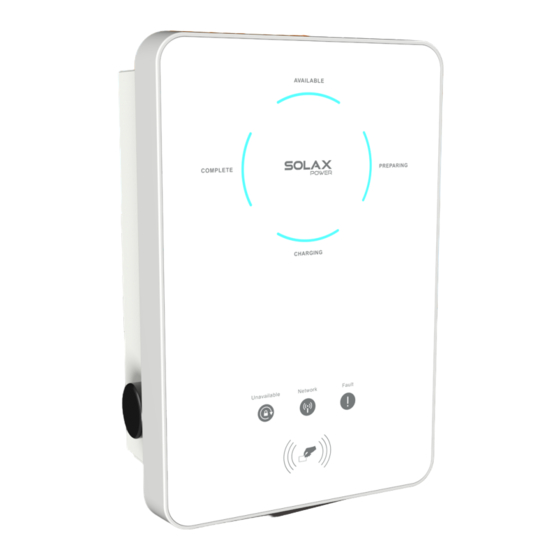
Table of Contents
Advertisement
Quick Links
X1/X3-EVC
User Manual
X1-EVC-7.2K(SXC) / X3-EVC-11K(SXC) / X3-EVC-22K(SXC)
X1-EVC-7.2K(PXC) / X3-EVC-11K(PXC) / X3-EVC-22K(PXC)
X1-EVC-7.2K(SXC)-P / X1-EVC-7.2K(PXC)-P
X3-EVC-11K(SXC)-P / X3-EVC-11K(PXC)-P
X3-EVC-22K(SXC)-P / X3-EVC-22K(PXC)-P
www.solaxpower.com
eManual in the QR code or at
https://kb.solaxpower.com/
Download.html
Advertisement
Table of Contents

Summarization of Contents
STATEMENT
Copyright
Details the copyright ownership of the manual and its content.
Trademarks
Information regarding the SolaX brand and its trademark protection.
Notice
Provides important disclaimers and notes about the manual's content and product scope.
About This Manual
Scope of Validity
Defines the specific X1/X3-EVC series EV-Chargers covered by this manual.
Target Group
Identifies the qualified personnel intended to perform installation and maintenance.
Conventions
Safety Symbols and Definitions
Explains the meaning of safety symbols (DANGER, WARNING, CAUTION, NOTICE) used in the document.
Change History
Records the version history and initial release date of the manual.
1 Safety
1.1 General Safety
Covers overall safety precautions and responsibilities for EV-Charger installation and use.
1.2 Safety Instructions
Provides critical safety instructions to prevent damage to the EV-Charger and ensure user safety.
Safety Warnings and Precautions
Details critical DANGER, WARNING, CAUTION, and NOTICE statements for safe operation and handling.
2 Product Overview
2.1 System Description
Describes the X1/X3-EVC series EV chargers and their intended purpose.
2.2 Supported Power Grid
Explains the grid system compatibility for TN-S and TN-C-S models.
2.3 Appearance
Illustrates the physical components and design of the EV-Charger socket and plug types.
2.3.1 Dimensions
Provides the physical dimensions for both socket and plug type EV-Chargers.
2.3.2 LED Panel
Defines the indicators and their meanings on the EV-Charger's LED panel.
2.3.3 Symbols on the Label
Explains the meaning of various certification and safety symbols found on the EV-Charger label.
2.4 Principle Circuit Diagram
Shows the functional block diagram and electrical connections of the EV-Charger.
2.5 Basic Features
Lists the key features and functionalities of the X1/X3-EVC series EV-Chargers.
3 Transportation and Storage
Transportation Guidelines
Outlines precautions and best practices for safely transporting the EV-Charger.
Storage Requirements
Specifies the conditions necessary for proper indoor storage of the EV-Charger.
4 Preparation before Installation
4.1 Selection of Installation Location
Details criteria for choosing an appropriate and safe installation site for the EV-Charger.
4.1.2 Installation Carrier Requirement
Specifies requirements for the mounting surface and structural support for the EV-Charger.
4.1.3 Clearance Requirement
Defines the minimum space needed around the EV-Charger for heat dissipation and access.
4.2 Tools Requirement
Lists the necessary tools for performing the installation of the EV-Charger.
4.3 Additionally Required Materials
Specifies additional materials needed for the installation, such as RCBO and cables.
5 Unpacking and Inspection
5.1 Unpacking Procedure
Provides instructions on how to safely unpack the EV-Charger and check for damage.
5.2 Scope of Delivery
Lists all the components and accessories included in the EV-Charger package.
6 Installation and Wiring
6.1 Decide Application Scenario
Guides users in selecting the correct application scenario (Home, OCPP) before installation.
6.2 Installation and Wiring Steps
Provides detailed, step-by-step instructions for the mechanical installation and electrical wiring.
7 Power on
7.1 Checking before Powering on
Lists essential checks to perform before activating the EV-Charger.
7.2 Powering on
Details the procedure for safely powering on the EV-Charger and verifying its status.
8 App Setting
8.1 Download, Registration and Login
Instructions for downloading, registering, and logging into the SolaX Cloud App.
8.2 Configuration
Guides on adding the EV-Charger device and configuring Wi-Fi connection.
8.3 Settings for EV-Charger
Explains how to access and modify settings for the EV-Charger via the App.
9 Operation Method
9.1 States
Describes the different operating states of the EV-Charger indicated by its LED lights.
9.2 Start-up Patterns
Details the available methods for starting the EV-Charger: plug & charge, card-swiping, APP activation.
9.3 Application Scene Setting
Instructions on setting the application scene, including Home and OCPP modes.
9.4 RFID Function Operation
Explains how to use the RFID card for activation and operation of the EV-Charger.
9.5 Detailed Function Operation
Covers advanced charging modes, boost settings, load balancing, and other operational features.
10 Troubleshooting and Maintenance
10.1 Power off
Procedure for safely powering off the EV-Charger before maintenance.
10.2 Troubleshooting
Provides common error codes, faults, and solutions for resolving EV-Charger issues.
10.3 Maintenance
Outlines the recommended regular maintenance checks and intervals for the EV-Charger.
11 Decommissioning
11.1 Disassembling the EV-Charger
Step-by-step guide for safely removing the EV-Charger from its installation.
11.2 Packing the EV-Charger
Instructions on how to pack the EV-Charger for storage or relocation.
11.3 Disposing of the EV-Charger
Guidance on the proper disposal of the EV-Charger according to electronic waste regulations.
12 Technical Data
General Data
Presents general specifications for different EV-Charger models, including electrical and physical properties.
Security & Protection
Details the safety features, protection mechanisms, and standards compliance of the EV-Charger.
Contact Information
Global Support Locations
Lists contact details for SolaX Power support across various countries for assistance.

Need help?
Do you have a question about the X3-EVC Series and is the answer not in the manual?
Questions and answers